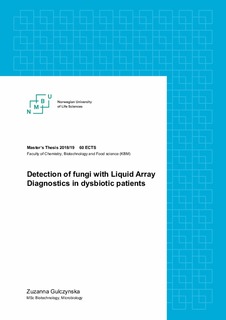| dc.contributor.advisor | Rudi, Knut | |
| dc.contributor.author | Gulczynska, Zuzanna | |
| dc.date.accessioned | 2019-08-30T08:49:49Z | |
| dc.date.available | 2019-08-30T08:49:49Z | |
| dc.date.issued | 2019 | |
| dc.identifier.uri | http://hdl.handle.net/11250/2611778 | |
| dc.description.abstract | Tarmmikrobiota dysbiose forbindes med diverse medisinske tilstander, inkludert inflammatorisk tarmsykdom (IBD) og irritabel tarmsyndrom (IBS). Som følge av mange år med omfattende forskning innen tarmmikrobiota, er noen bakterier i dag assosiert med dysbiose, mens andre er assosiert med normobiotisk tilstand. Disse assosiasjoner var grunnlaget til utviklingen av GA-map Dysbiosis Test – et probe-basert diagnostisk verktøy for bestemmelse av dysbiosenivå, oppgitt som Dysbiose Index (DI). En ny teknologi, Liquid Array Diagnostics (LAD), er under utvikling for å utfylle GA-map Dysbiosis Test, med hensyn til dets tilgjengelighet og kostnadseffektivitet. De siste årene har studier tilknyttet tarmmikrobiota blitt utvidet til å fokusere på andre mikroorganismer som er tilstede i tarmen, blant annet fungi. I noen studier har det blitt rapportert at dysbiose-relaterte mønstre kan observeres også blant tarmmycobiota. Disse mønstrene inkluderer skjev Basidiomycota/Ascomycota ratio, økt andel av Candida albicans og redusert andel av Saccharomyces cerevisiae. Målet med denne studien var å identifisere mycobiotas sammensetning i avføringsprøver med forskjellige DI, og å evaluere utvalgte fungi som potensielle mål for LAD-prober. For å oppnå dette ble mikro- og mycobiota av 43 avføringsprøver kvantifisert og identifisert ved hjelp av Illumina sekvensering. Sekvenseringsresultatene ble benyttet til å evaluere assosiasjoner mellom fungi og dysbiosenivå. 10 målorganismer var utvalgt til LAD-probe design. LAD ble så utført på de originale 43 avføringsprøvene, og sekvenseringsresultatene ble benyttet. Til tross for at ingen taksonomiske mønstre assosiert med dysbiose ble identifisert, ble alle målorganismer detektert ved bruk av LAD. Det var et godt samsvar mellom LADs nøyaktighet og Illumina sekvensering. LAD har et stort potensial til bruk i klinisk sammenheng. Imidlertid behøves det flere studier til å identifisere og bekrefte dysbiose-assosierte fungi, før prober rettet mot fungi kan inkluderes i en LAD-dysbiose analyse. | nb_NO |
| dc.description.abstract | Gut microbiota dysbiosis is connected with various medical conditions, including inflammatory bowel disease (IBD) and irritable bowel syndrome (IBS). Years of extensive research on gut microbiota revealed many bacterial taxa which are indicative of dysbiosis or normobiosis. These findings lead to development of GA-map Dysbiosis Test, a diagnostic tool for assessment of the degree of dysbiosis expressed as Dysbiosis Index (DI), based on probes targeting different bacterial taxa. A new technology, Liquid Array Diagnostics (LAD), is in development and aims to complement GA-map Dysbiosis Test in terms of cost-effectivity and availability. In recent years, the focus of microbiota studies has been shifted to also examine other microorganisms, such as fungi. A number of studies reported that certain mycobiota patterns can be observed in dysbiotic samples, including skewed Basidiomycota/Ascomycota ratio, increased Candida albicans proportion and decreased Saccharomyces cerevisiae proportion. The aim of this study was to identify mycobiota composition in a set of faecal samples of various DI and assess fungi as potential probe targets for LAD. The micro- and mycobiota of 43 faecal samples was first quantified and then identified through Illumina sequencing. Sequencing results were examined for fungal associations with dysbiosis, and 10 targets were chosen for designing of LAD probes. LAD analysis was performed on the same 43 samples using Illumina results as control. Although no taxonomic patterns associated with dysbiosis were found, all targets were successfully detected with LAD. The accuracy of LAD analysis also showed good compliance with Illumina. Although LAD shows a great potential for use in clinical context, more studies are needed to identify and confirm fungal taxa associated with dysbiosis before any fungal targets can be included in the assay. | nb_NO |
| dc.language.iso | eng | nb_NO |
| dc.publisher | Norwegian University of Life Sciences, Ås | nb_NO |
| dc.rights | Attribution-NonCommercial-NoDerivatives 4.0 Internasjonal | * |
| dc.rights.uri | http://creativecommons.org/licenses/by-nc-nd/4.0/deed.no | * |
| dc.subject | IBD | nb_NO |
| dc.subject | IBS | nb_NO |
| dc.subject | LAD | nb_NO |
| dc.subject | Tarmmicrobiota | nb_NO |
| dc.subject | Dysbiose | nb_NO |
| dc.subject | Gut microbiota | nb_NO |
| dc.subject | Dysbiosis | nb_NO |
| dc.title | Detection of fungi with Liquid Array Diagnostics in dysbiotic patients | nb_NO |
| dc.type | Master thesis | nb_NO |
| dc.description.localcode | M-BIOTEK | nb_NO |

